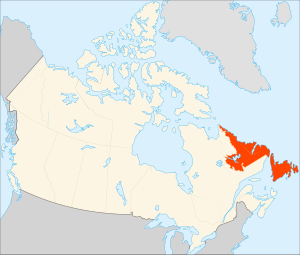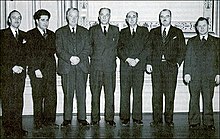1948 Newfoundland referendums

The Newfoundland referendums of 1948 were a series of two
Background
Newfoundland was the first region in what would become Canada to be settled by Europeans, but was the last to obtain either a local
Newfoundland did not send any delegates to the 1864
By the 1920s and the 1930s, Newfoundland was almost $40 million in debt,[3] and on the verge of economic collapse. A commission recommended Newfoundland to be "given a rest from party politics"[3] and to be administered by a special Commission of Government. Chaired by the governor, it would consist of three people from Newfoundland and three from the United Kingdom.[3] Backing the recommendation was the United Kingdom, which agreed to take on Newfoundland's debts. The Commission of Government began on February 16, 1934.
Prosperity returned when the Americans were invited to the island by Britain to set up military bases in 1941 to 1945. The American Bases Act became law in Newfoundland on June 11, 1941. Newfoundland girls married American personnel by the thousands.[4] In 1948 there was a short-lived but growing movement for some sort of economic union with the United States.
The British government, keen to cut expenditure after World War II, hoped that Newfoundland would decide to join confederation and end the rule by commission.[5] Newfoundland first asked Canada for help in a return to responsible government. However, the response from the Canadian government was that it was not interested in helping Newfoundland economically unless Newfoundland joined Confederation.[5]
The British did not want their colony to become an American possession, and the Canadian government, despite being convinced that absorbing Newfoundland would not benefit Canada economically, thought that the annexation would be the lesser of two evils when compared to the prospect of the country being almost completely surrounded by American territory.[6]
Seeking a union with the United States was not a referendum option, despite the idea having some currency amongst locals. With the
Newfoundland National Convention
The British government decided to let Newfoundlanders deliberate and choose their own future by calling a National Convention in 1946. Chaired by Judge Cyril J. Fox, it consisted of 45 elected members, one of whom was the future first premier of Newfoundland, Joey Smallwood.[7]
The Convention set up committees to study where Newfoundland's future lay. Many members assumed that the final decision was due near the end of their deliberations, but the timeline was upset when Smallwood moved that the Convention should send a delegation to Ottawa to discuss a union in October 1946.[7] His motion was defeated, as it only received the support of 17 members, although the Convention later decided to send delegations to both London and Ottawa.
London delegation

The London delegation, made up of so-called anti-confederates, preferred that Newfoundland become independent rather than join Canada.
Ottawa delegation
The Ottawa delegation, dominated by pro-confederates including Smallwood, preferred a union with Canada to independence.[8] The talks between them and Ottawa began on June 24, 1947 with the goal being to stay in Ottawa as long as needed to negotiate good terms for Newfoundland's entry. Ottawa was reluctant at first because they felt that the delegation was not an official representation of the Dominion of Newfoundland, but the Federal Cabinet finally decided to begin negotiations on July 18.[8] By mid-August, the agreement of draft terms was nearly complete. However, with the death of Frank Bridges, Prime Minister William Lyon Mackenzie King's minister from New Brunswick, negotiations effectively ended. King refused further discussions until New Brunswick had representation,[8] and so the delegation headed back to St. John's.
Back in St. John's
The Convention reconvened on October 10 and Smallwood presented his delegation's report, infuriating the anti-confederates.[8] Just as the Convention decided to debate the delegation's report, the draft terms from Ottawa arrived. Ottawa offered to assume most of the debt, negotiate a tax agreement, and outlined which services would remain in the jurisdiction of the province.[8]
Referendums
Newfoundland recommended that the British Government hold a referendum on Newfoundland's future. London agreed that a referendum was a good idea, and left it up to the Convention to decide what was to be on the ballot. Originally, the Convention decided that only two choices were to be on the ballot: restoration of responsible government and the continuation of the Commission of Government.[8][9]
Smallwood moved on January 23, 1948, to add Confederation with Canada to the choices. The debate ended at 5:30 a.m. on January 28, with the motion being defeated 29–16.[8] The British government intervened in March and overruled the Convention, deciding that Confederation with Canada would indeed be on the ballot.[9] They did this after having concluded, "It would not be right that the people of Newfoundland should be deprived of an opportunity of considering the issue at the referendum".[9]
Factions
Three main factions actively campaigned during the lead up to the referendums. One faction, led by Smallwood, was the
First referendum
The first referendum took place on June 3, 1948. The votes were as follows:[9]
| Choice | Votes | % of Votes |
|---|---|---|
| Responsible Government | 69,400 | 44.5% |
| Confederation with Canada | 64,066 | 41.1% |
Commission of Government
|
22,331 | 14.3% |
| Total votes | 155,797 | 88% (of total electorate) |
Second referendum
Since none of the choices had gained over 50%, a second referendum with only the two most popular choices was scheduled for July 22, 1948. Both sides recognized that more people had voted against responsible government than for it, which encouraged the CA and discouraged its opponents, although the RGL and EUP now became allies. The confederates widely publicized the
The results of the second referendum were:[9]
| Choice | Votes | % of Votes |
|---|---|---|
| Responsible Government | 71,334 | 47.7% |
| Confederation with Canada | 78,323 | 52.3% |
| Total votes | 149,657 | 85% (of total electorate) |
Results map
The Avalon Peninsula, the location of St. John's, supported responsible government in both referendums, while the rest of Newfoundland supported confederation. A majority of districts with mostly Catholic voters supported responsible government.[10]
Reaction to the referendums
As the results of the binding referendum were to join Canada, Newfoundland began to negotiate with Canada to enter into Confederation. After negotiations were completed, the British Government received the terms and the
Newfoundland as a province secured some significant guarantees as a part of the union. As ruled by the
Canada welcomed Newfoundland into confederation, as seen in an editorial in The Globe and Mail on April 1, 1949:
Union with Newfoundland, as everyone knows, rounds out the dream of the Fathers of Confederation. This newspaper is certain that Canadians welcome their new fellow-countrymen with full hearts. May the union be forever a blessing for Canada and to the island which is yielding its ancient independence, but not its identity, to belong to a larger fraternity.[13]
An editorial from the
For Canadians tomorrow will be a day of welcome. For this is the day when a tenth province is added to the Dominion of Canada. There will be a greater meaning than ever to the Canadian motto, chosen by Sir
Leonard Tilley from the words of Isaiah which describes the dominion that reaches 'from sea to sea'.[14]
The Vancouver Sun also reflected on the results, saying:
Today a dream of greatness, present in the minds of the Fathers of Confederation more than 80 years ago, comes true. Newfoundland at long last is part of Canada.[15]
References
- ^ a b "The Development of Self-Government in Newfoundland". .marianopolis.edu. Archived from the original on September 10, 2006. Retrieved December 3, 2010.
- ^ "First Confederation Talks of Newfoundland With Canada)". .marianopolis.edu. Archived from the original on September 10, 2006. Retrieved December 3, 2010.
- ^ a b c "The Great Depression, Economic Collapse in Newfoundland and Newfoundland's Loss of Responsible Government". .marianopolis.edu. Archived from the original on July 20, 2008. Retrieved December 3, 2010.
- ^ .
- ^ a b "British Policy and Newfoundland". Heritage.nf.ca. Retrieved December 3, 2010.
- ^ Dyer, Gwynne (March 2003). "The Strategic Importance of Newfoundland and Labrador to Canada" (PDF). Royal Commission on Renewing and Strengthening Our Place in Canada. Retrieved November 26, 2011.
- ^ a b c d "The Newfoundland National Convention". Heritage.nf.ca. Retrieved December 3, 2010.
- ^ a b c d e f g "The Ottawa Delegation, 1947". Heritage.nf.ca. June 24, 1947. Retrieved December 3, 2010.
- ^ a b c d e f "Newfoundland Joins Canada) and Newfoundland and Confederation (1949)". .marianopolis.edu. Archived from the original on July 20, 2008. Retrieved December 3, 2010.
- ^ a b c Hiller, J. K. (1997). "The 1948 Referendums". Newfoundland and Laborador Heritage. Memorial University of Newfoundland. Retrieved November 26, 2011.
- ^ Newfoundland: Aftermath Archived November 11, 2006, at the Wayback Machine
- ^ a b Expectations as We Joined Canada from the Government of Newfoundland
- ^ "Editorial from The Globe and Mail". .marianopolis.edu. April 1, 1949. Archived from the original on September 10, 2006. Retrieved December 3, 2010.
- ^ "Editorial from the Montreal Gazette". .marianopolis.edu. March 31, 1949. Archived from the original on September 10, 2006. Retrieved December 3, 2010.
- ^ "Editorial from the Vancouver Sun". .marianopolis.edu. April 1, 1949. Archived from the original on September 10, 2006. Retrieved December 3, 2010.
Further reading
- Argyle, Ray (2004). Turning Points: The Campaigns that Changed Canada 2004 and Before. Toronto: White Knight Publications. ISBN 978-0-9734186-6-8.
External links

